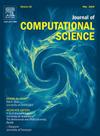在生物模式形成的背景下求解Gierer-Meinhardt (G-M)模型的计算方法
IF 3.7
3区 计算机科学
Q2 COMPUTER SCIENCE, INTERDISCIPLINARY APPLICATIONS
引用次数: 0
摘要
一个特别关注发育生物学的数学框架可以从Gierer-Meinhardt模型中获得,该模型解释了生物系统中空间模式的出现。当不同的化学物质以复杂的方式相互作用时,这些模式就会出现,遵循结构化的数学框架(Gierer-Meinhardt模型),这有助于解释这些模式是如何随着时间的推移而发展的。动物皮肤上条纹的产生和胚胎发育的组织是通常涉及这些图案的生物学过程。本文通过引入激活函数(如径向基函数)对Gierer-Meinhardt模型进行了详细的数学分析。研究结果表明,径向基函数神经网络是分析此类复杂数学模型的有效工具。通过将成熟的生物模型与像ANN-RBF网络这样的计算工具相关联,为研究生命系统的复杂性创造了新的机会,并为进一步研究发育生物学和其他领域奠定了基础。本文章由计算机程序翻译,如有差异,请以英文原文为准。
A computational approach for solving the Gierer-Meinhardt (G-M) model in the context of biological pattern formation
A mathematical framework with a particular focus on developmental biology can be attained from the Gierer-Meinhardt model, which explains the emergence of spatial patterns within biological systems. These patterns emerge when different chemical substances interact in a complicated manner, following a structured mathematical framework (Gierer-Meinhardt model), which helps explain how these patterns develop over time. The production of animal stripes on the skin and the organization of embryonic development are biological processes that usually involve these patterns. The present study conducts a detailed mathematical analysis of the Gierer-Meinhardt model by incorporating activation function such as radial basis function. The findings of the present study indicate that the radial basis function neural network is an effective tool for analyzing such complex mathematical models. By correlating the well-established biological models with computational tools like the ANN-RBF networks, new opportunities are created for examining the intricacy of living systems, and the foundation for further research in developmental biology and other fields.
求助全文
通过发布文献求助,成功后即可免费获取论文全文。
去求助
来源期刊

Journal of Computational Science
COMPUTER SCIENCE, INTERDISCIPLINARY APPLICATIONS-COMPUTER SCIENCE, THEORY & METHODS
CiteScore
5.50
自引率
3.00%
发文量
227
审稿时长
41 days
期刊介绍:
Computational Science is a rapidly growing multi- and interdisciplinary field that uses advanced computing and data analysis to understand and solve complex problems. It has reached a level of predictive capability that now firmly complements the traditional pillars of experimentation and theory.
The recent advances in experimental techniques such as detectors, on-line sensor networks and high-resolution imaging techniques, have opened up new windows into physical and biological processes at many levels of detail. The resulting data explosion allows for detailed data driven modeling and simulation.
This new discipline in science combines computational thinking, modern computational methods, devices and collateral technologies to address problems far beyond the scope of traditional numerical methods.
Computational science typically unifies three distinct elements:
• Modeling, Algorithms and Simulations (e.g. numerical and non-numerical, discrete and continuous);
• Software developed to solve science (e.g., biological, physical, and social), engineering, medicine, and humanities problems;
• Computer and information science that develops and optimizes the advanced system hardware, software, networking, and data management components (e.g. problem solving environments).
 求助内容:
求助内容: 应助结果提醒方式:
应助结果提醒方式:


